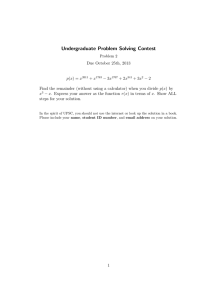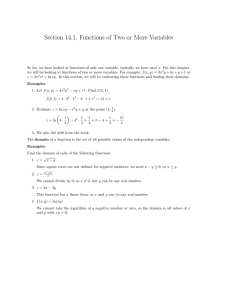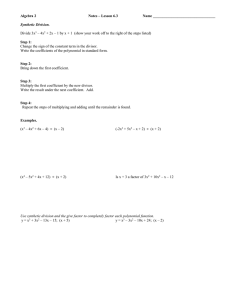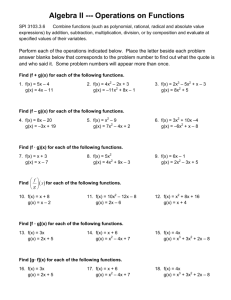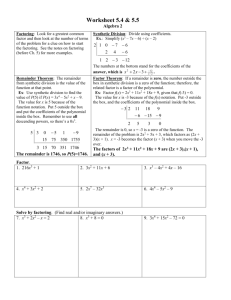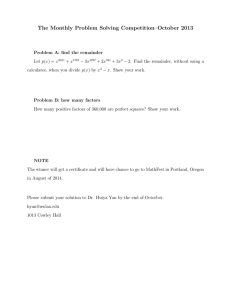3.5B – Synthetic Division
advertisement
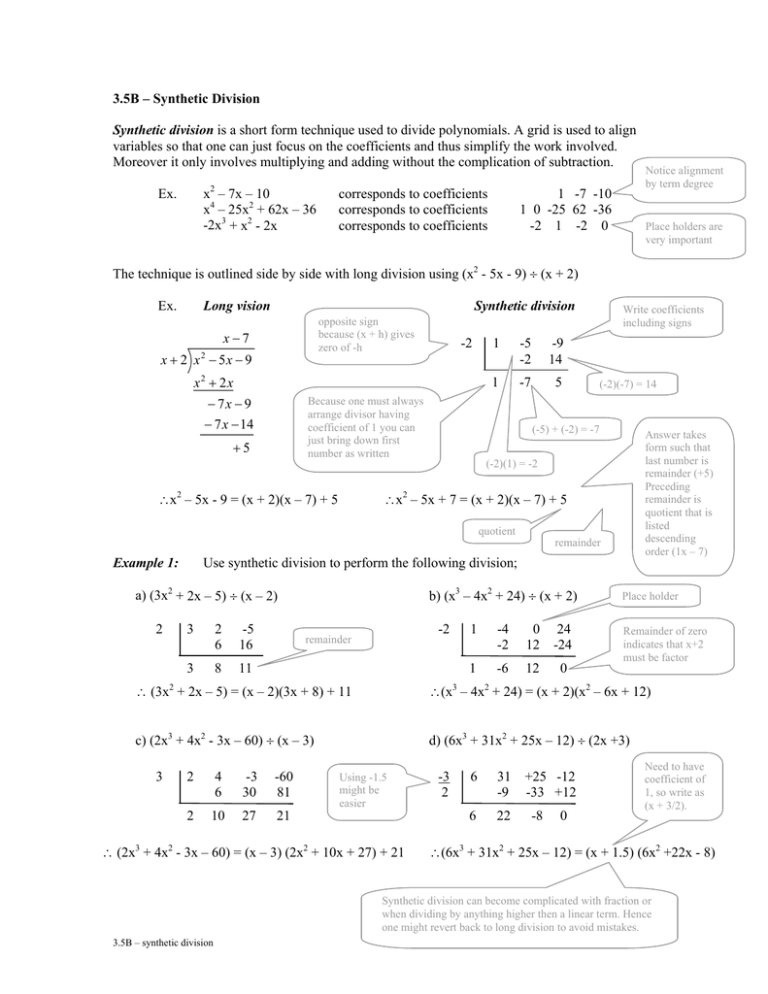
3.5B – Synthetic Division Synthetic division is a short form technique used to divide polynomials. A grid is used to align variables so that one can just focus on the coefficients and thus simplify the work involved. Moreover it only involves multiplying and adding without the complication of subtraction. x2 – 7x – 10 x4 – 25x2 + 62x – 36 -2x3 + x2 - 2x Ex. corresponds to coefficients corresponds to coefficients corresponds to coefficients 1 -7 -10 1 0 -25 62 -36 -2 1 -2 0 Notice alignment by term degree Place holders are very important The technique is outlined side by side with long division using (x2 - 5x - 9) ÷ (x + 2) Ex. Long vision Synthetic division opposite sign because (x + h) gives zero of -h x−7 x + 2 x − 5x − 9 2 x2 + 2 x − 7x − 9 − 7 x − 14 -2 Because one must always arrange divisor having coefficient of 1 you can just bring down first number as written +5 ∴x2 – 5x - 9 = (x + 2)(x – 7) + 5 1 -5 -2 -9 14 1 -7 5 Write coefficients including signs (-2)(-7) = 14 (-5) + (-2) = -7 Answer takes form such that last number is remainder (+5) Preceding remainder is quotient that is listed descending order (1x – 7) (-2)(1) = -2 ∴x2 – 5x + 7 = (x + 2)(x – 7) + 5 quotient remainder Use synthetic division to perform the following division; Example 1: a) (3x2 + 2x – 5) ÷ (x – 2) 2 3 2 6 -5 16 3 8 11 b) (x3 – 4x2 + 24) ÷ (x + 2) -2 remainder 1 1 -4 -2 0 24 12 -24 -6 12 0 Place holder Remainder of zero indicates that x+2 must be factor ∴ (3x + 2x – 5) = (x – 2)(3x + 8) + 11 ∴(x – 4x + 24) = (x + 2)(x2 – 6x + 12) c) (2x3 + 4x2 - 3x – 60) ÷ (x – 3) d) (6x3 + 31x2 + 25x – 12) ÷ (2x +3) 2 3 2 4 6 -3 30 -60 81 2 10 27 21 3 Using -1.5 might be easier ∴ (2x3 + 4x2 - 3x – 60) = (x – 3) (2x2 + 10x + 27) + 21 -3 2 2 6 31 -9 6 22 +25 -12 -33 +12 -8 0 Need to have coefficient of 1, so write as (x + 3/2). ∴(6x3 + 31x2 + 25x – 12) = (x + 1.5) (6x2 +22x - 8) Synthetic division can become complicated with fraction or when dividing by anything higher then a linear term. Hence one might revert back to long division to avoid mistakes. 3.5B – synthetic division 3.5B – Synthetic Division Practice Questions 1. Use synthetic division to divide. Express answer in form f(x) = d(x) q(x) + r(x) a) (x2 - 3x + 5) ÷ (x – 2) c) (3x2 – 4) ÷ (x – 4) e) (x3 + 3x2 - 16x + 12) ÷ (x – 2) g) (9x3 – 3x2 - 4x +2) ÷ (x – 2/3) i) (x3 – 9x2 + 26x – 24) ÷ (x – 2) k) (x4 + 63x – 5) ÷ (x + 4) m) (x4 + 3x2 + 4) ÷ (x2 + 2x – 1) b) (3x2 + 2x – 5) ÷ (x – 2) d) (m3 – m2 + 4m + 15) ÷ (m2 + 2m – 3) f) (6a3 + 4a2 + 9a + 6) ÷ (3a +2) h) (4x3 + 32) ÷ (x +2) j) (-x3 + 3x + 2) ÷ (x – 2) l) (3x3 – 72x – 5) ÷ (x – 5) n) (6x5 – 7x + 4) ÷ (x + 1) Which of these questions are best down with synthetic division. Which questions are best done using long division to avoid mistakes? 2. Find the value of k such that when 2x3 - 3x2 + kx – 1 is divided by x - 1 the remainder is 2. 3. When a given polynomial is divided by x – 2, its quotient is x2 – 3x – 7 and its remainder is -24. What is the original dividend polynomial? 4. Find the quotient only; a) y 3 − 28 y − 41 y+4 b) 4 x3 − 10 x 2 + 6 x − 15 2x − 5 Answers 1. a) (x-2)(x-1) + 3 b) (x-2)(3x+8) + 11 c) (x-4)(3x+12) + 44 d) (m2+2m-3)(m-3) + (13m+6) e) (x–2)(x2+5x-6) or (x–2)(x+6)(x+1) f) (3a+2)(2a2+3) or (a+2/3)(6a2+9) g) (x-2/3)(9x2+3x-2) + 2/3 h) (x+2)(4x2-8x+16) i) (x-2)(x-3)(x-4) j) (x-2)(-1)(x+1)(x+1) or –(x-2)(x+1)2 k) (x+4)(x3-4x2-16x-1)-1 l) (x-5)(3x2+15x+3)+10 m) (x2+2x-1)(x2-2x+8)-(18x+12) n) (x+1)(6x4-6x3+6x2-6x-1)+5 2. 4 3. x3-5x2-x-10 4. a) y2-4y-12 b) 2x2+3 or 4x2+6 3.5B – synthetic division

![Homework 12: Due Wednesday 7/9/14 on the interval [−1, 2]?](http://s2.studylib.net/store/data/011229144_1-0554531fc36f41436ee2a5dab6cfe618-300x300.png)

